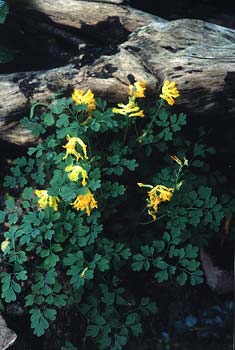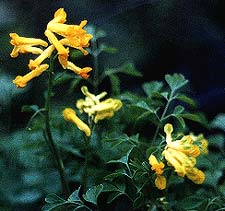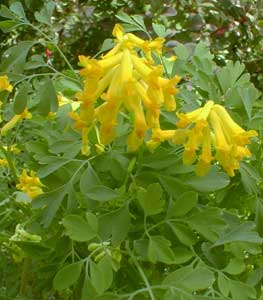
Yellow Corydalis; aka: Yellow Fumitory, Pseudofumaria, Hollowort, or Yellow Larkspur
"Down the furrow dry
Sunspurge & oxeye
And laced-leaved lovely
Foam-tuft fumitory."
-Gerard Manley Hopkins
1844-1889
1844-1889
"Corydalis" is Greek for "Lark" & as with delphinium larkspurs, the name alludes to the spurred rear of the flowers.
The old common name Fumitory (& such variants as Fumaria, Fumiterre, Vapor Herb, or Earth Smoke), earlieste applied to Fumaria officianalis, is of such early coinage that the reason for this name is debated. Some of the theories about this name are bound to be retroactively applied, but have been thus applied for so long that the genera Corydalis, Dicentra & Fumeria have had a great body of superstitions attached to them.
John Gerard in his 1597 Herball speculated the name was applied to it because it caused one's eyes to water as would smoke, though this seems an unlikely origin. Other theories are that it was once used as a fumigant, & the name lasted longer than the practice. Some commentators state that it was in medieval times burnt during exorcism rites or spells of witchcraft, though the evidence of this being so appears to be strictly folkloric. In 1820, John Hill alleged that it was dried & smoked like tobacco as a treatment for headache. Or it was from ancient times believed that species of fumitories sprang up spontaneously in fields of barley, without benefit of seeding itself, like smoke seeping from cracks in the earth, therefore was called "The Smoke of the Earth."
 I've wondered if it mightn't once have been used in sybilline rites, the transluscent white corms having psychotropic properties of inducing visions, & sybils dwelt often in caverns with a smoky hearth. I've no good basis for this notion, though Fumitory is derived from fumiterre meaning "the smoke of the earth," which is possibly a very ancient religious allusion to sacred caverns with volcanic vents, or sybils with their cavern hearth rituals.
I've wondered if it mightn't once have been used in sybilline rites, the transluscent white corms having psychotropic properties of inducing visions, & sybils dwelt often in caverns with a smoky hearth. I've no good basis for this notion, though Fumitory is derived from fumiterre meaning "the smoke of the earth," which is possibly a very ancient religious allusion to sacred caverns with volcanic vents, or sybils with their cavern hearth rituals.Corydalis lutea is a shortlived perennial wildflower native to the southern Alps of Europe. It likes somewhat alkaline soil but does medium-well in our garden's naturally acidic soils. It wants a bit more sunlight than most corydalises, yet does well in dappled shade, growing to about a foot or eighteen inches height, wanting persistant moisture but not bogginess.
The bright yellow summer flowers occur as early as May, are at their height during the summer, & frequently persist until October or first frost.
In our temperate weather, it sometimes approaches being nearly evergreen. It almost makes it through winter still nice & ferny, though it does require a short dormancy & will eventually vanish before winter's end. Yet it will be growing back before spring begins, so is not gone long at all.
 In hot summers it may die back or become so dried out it needs clipping to the gorund, though in cooler zones, with moist ground, it is at its flowery peak in summer & does not die back at all, unlike the majority of more easily heat-stressed corydalises.
In hot summers it may die back or become so dried out it needs clipping to the gorund, though in cooler zones, with moist ground, it is at its flowery peak in summer & does not die back at all, unlike the majority of more easily heat-stressed corydalises.Though in 2002 the clump bloomed almost perpetually spring to autumn & the foliage did not die back, in summer 2003 we had so many record hot days that the Yellow Corydalis completely disappeared. When it did not reappear in autumn, I assumed it was dead. But when transplanting a fern into the spot that had previously had the yellow corydalis, I uncovered an odd little bulb, which was like a cluster of squirrel-teeth around a tough little sprout. I replanted this among little wood anemones. There had also been additional yellow corydalis seedlings that appeared in March 2003, each miniscule plant attached to a separate squirrel-tooth. But none of these made it through the record-hot summer.
Though hardiest to zone 7, it is still apt to have good summer growth in zone 8. It will definitely suffer in warmer zones though still possibly grown as a tender perennial or biennial. In cooler climates with low humidity it can naturalize & spread rapidly.
By its third year in quite a shady location, the yellow corydalis had pretty much died out of the garden. Yet I noticed at a friend's house that they had a large, aggressively spreading patch in full morning sun up near the foundation of the house, which location was probably a little more alkaline because of the cement. Theirs self-seeded dramatically & was not at risk of dying out of the yard over time. So in 2004 I planted more of it (shown in the third photo snapped at August's end). This time I selected a slightly sunnier spot next to a masonry path, hoping it will this time colonize a little area rather than dwindle year by year.